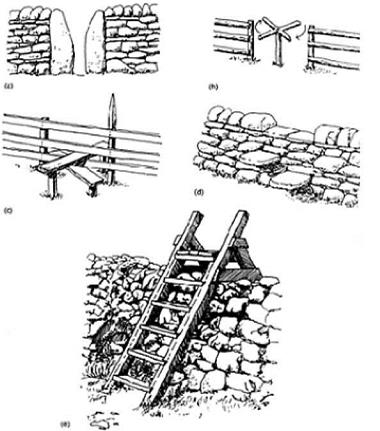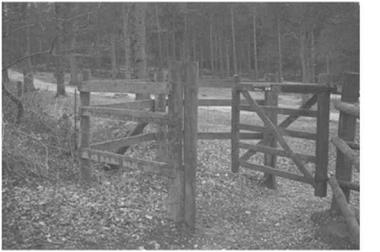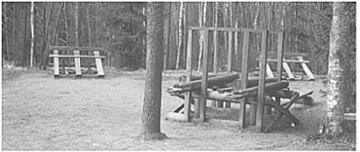There are many designs of gates suitable for use in most places, made of sawn timber with galvanized steel hinges and fasteners. If there is a risk of people leaving gates open, self-closing devices can be used, such as rising hinges, weights and automatic latches. Special leaning gates can be used in deer fences, but these can be heavy to lift, and there is a risk of their falling back on to people. One of the more reliable types is the kissing gate, which swings freely within a railed enclosure. The user walks in, swings the gate past and walks out. It can be built to allow access by wheelchairs and prams without allowing motorcycles or horses to pass. It should be the standard form of gate for trails that are likely to be used by people with disabilities and others who may experience similar difficulties.
 |
Stile designs: (a) A slit stile in a wall made from stone uprights, which taper to a narrower gap towards the bottom to prevent livestock from passing through it. (b) A turnstile constructed of timber with a galvanized steel spindle. (c) A traditional step stile in a timber rail fence.
The extended post makes a good handhold when climbing over it. (d) Stone steps set into the structure of a drystone wall is another traditional type of stile. (e) A ladder stile can be used to
climb over high walls or deer fences. This one is in Ennerdale Forest in the English Lake District.
 |
A kissing gate made so that
wheelchairs or baby buggies can negotiate it. New forest, Hampshire, England.
 |
An area set out with various types of trim or fitness equipment. It is all made from wood to simple designs, and it fits in well into this scene. Helsinki Central Park, Finland.
Fitness or trim trails
A special variety of trail much favoured in recreation areas closer to urban centres is the fitness or trim trail. This usually comprises a circular loop trail along which are positioned items of equipment used to exercise, tone and strengthen different sets of muscles. The equipmentmaybe spaced around the trail or clustered at certain points. The jog around the trail, between the different pieces of equipment, warms the person using it, as does the order in which the exercise equipment is used.
Construction of the exercise equipment in the outdoors looks best in wood—sawn or peeled and rounded. Metal tubing may be used for some pieces. Depending on the type of equipment it should be set in an area of hard surfacing to prevent wear and tear on the ground, or the surface should be covered in bark or wood chippings where falling from a height is possible.
Equipment should normally be set to one side of the trail so that it does not obstruct walkers who are not using it for fitness purposes. The equipment should be well spaced, numbered and provided with signs illustrating the way it should be used. Often each piece of equipment allows different degrees of fitness to be exercised, or is suited to different heights and ages of people. For example, lifting logs to make use of upper chest and arm muscles can range from light to heavy, or hurdles for jumping over can range from low to high.



